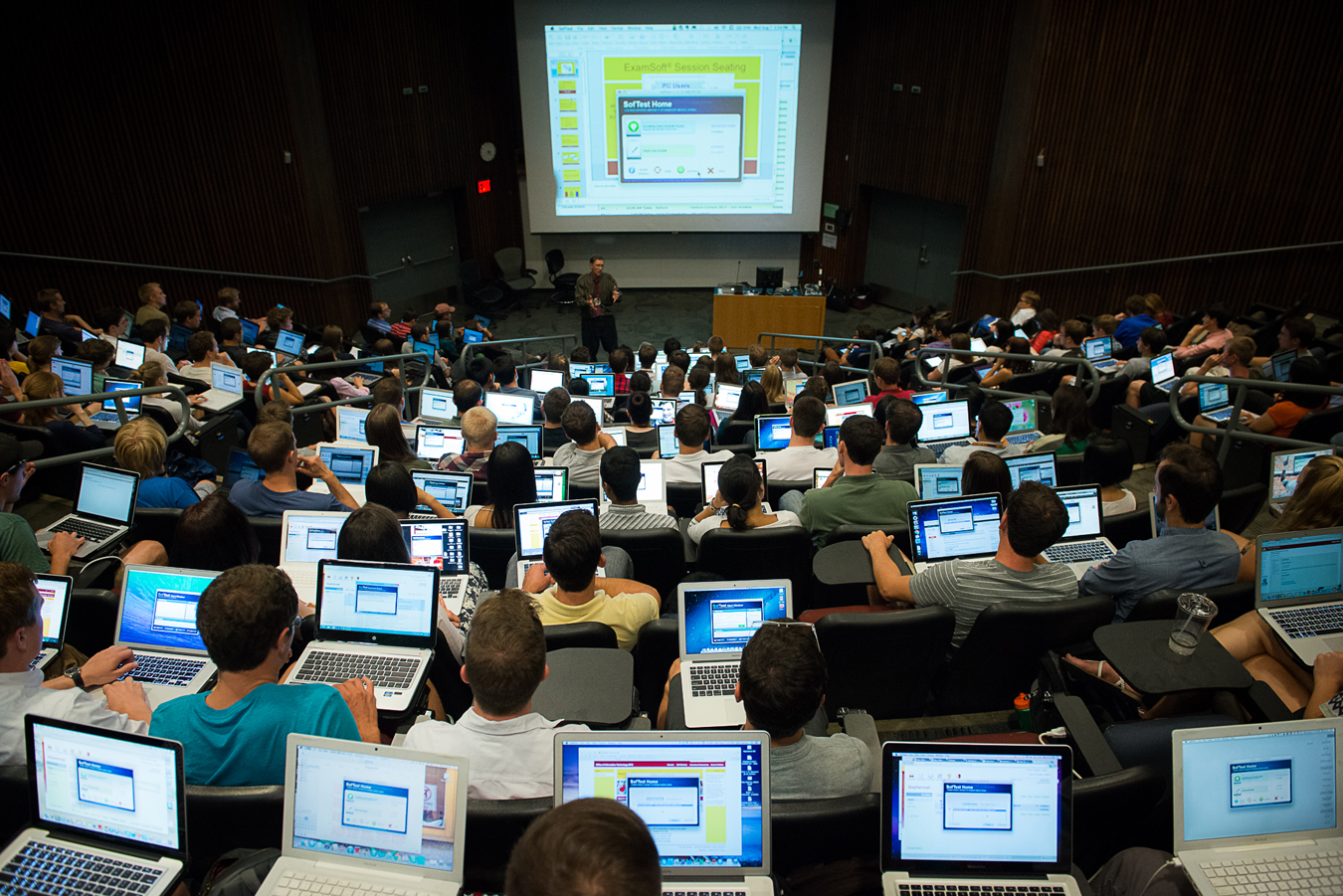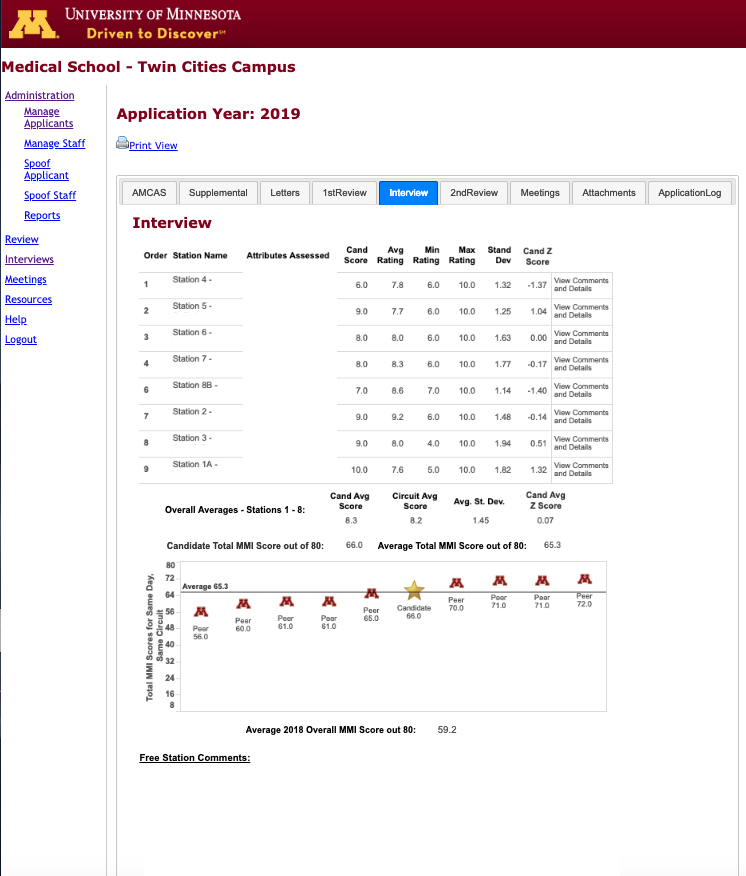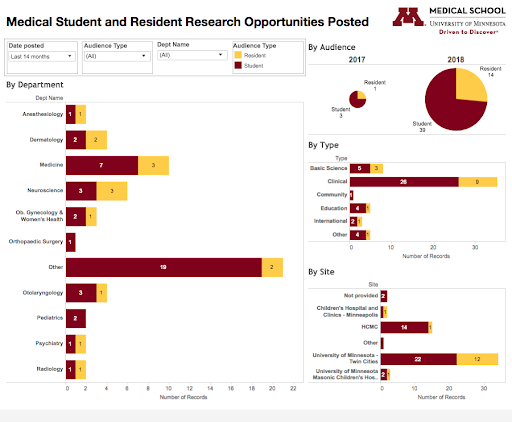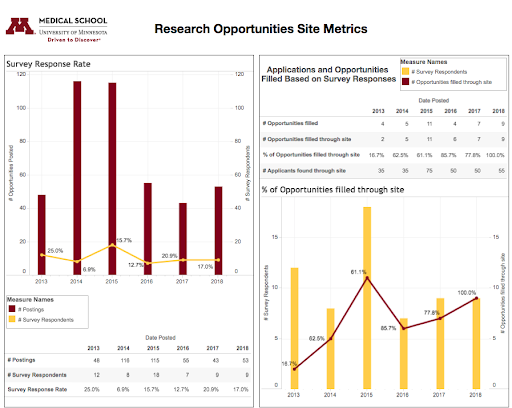


Discover
We provide comprehensive data analysis and can deliver results via interactive reports. Here is a selection of some our favorite past projects.
MEOC serves a number of different data-related needs ranging from day-to-day business process analyses to identification of trends. By providing data in an engaging and visual way, we facilitate the administrative and strategic mission of the Medical School.
To-date we have fulfilled over 430 distinct projects, with another 48 currently in the pipeline. These projects include both delivery of quality data packages as well as full-service analytics. We utilize Tableau as our default data delivery platform. For those requests that go beyond data delivery, we employ a wide range of methods. Below you’ll find a selection of just a few of our projects.
Transforming data into knowledge and catalyzing educational innovation to improve health and health equity.
Learn more about MEOC's goals, research questions, and other components.
View a sampling of peer-reviewed publications, presentations, and other outcomes from MEOC.
A selection and description of previously fulfilled requests
“The Match” is the process by which medical students are placed in a residency. MEOC created interactive visualizations to allow residents and others to view match data, including residents' names and match locations.

In this project, MEOC staff worked with Dean Brooks Jackson to compile and analyze student academic and demographic data in order to identify predictors of medical student performance. Using statistical analyses such as t-tests, correlations, multiple linear regression, ANOVA, and MANOVA, the researchers have begun to identify patterns in the relationships between variables such as MCAT scores, USMLE scores, residency specialties, honors society membership, age, and more. To date, this work has led to the publication of three articles in open-access academic medicine journals. Although Dean Jackson is now at the University of Iowa Medical School, collaboration continues, pooling data from both institutions.

In 2016, the Medical School began using a new interview process, called Multiple Mini Interviews (MMI). In this process, applicants are evaluated by trained raters on multiple different interview stations. MEOC staff facilitates this process by building and maintaining web-based dashboards for Admissions Committee members to efficiently view applicants’ MMI results and compare them to other applicants on their circuit. The dashboards are built into the Admissions processing tool, making it easy for reviewers to have all of the data at their fingertips.
MEOC staff also compile statistics regarding the process, analyze the data statistically to check for between-group differences and ensure rater reliability over time, and present regular updates at Admissions Committee meetings. MEOC staff compile reports of the results of Qualtrics surveys, which are completed by applicants and raters regarding their evaluations of the MMI process. Those reports are used by the Admissions Office to determine changes to implement to improve the MMI process, such as extending the length of a freeform conversation section to allow for more relationship development between the applicant and the interviewer.


Treating patients and teaching medical students are parallel activities that occur at teaching hospitals. However, the relationships between these activities are poorly understood. There have been multiple calls for assessing the quality of medical education by examining publicly available clinical data but there is minimal evidence linking these variables. In this proof-of-principle study, MEOC staff examined publicly available data collected by Minnesota Community Measurement to explore the relationships between patient evaluations of their hospital experience and medical student evaluations of the educational experience at that site.

The Enrichment Program was developed by the Medical School to better support incoming students in the initial medical school transition experience. Offered the week preceding Orientation, Enrichment focuses principally on the objectives of empowering students and promoting confidence (self-efficacy). Programmatic elements feature sessions on academic skills and resources, opportunities to connect with peer mentors, and more. MEOC staff run the evaluation of this program. We work with the Director of Learner Development to design pre- and post-surveys in Qualtrics of the empowerment and self-efficacy objectives, as well as evaluative ratings of the program and its specific elements. We distribute and administer these surveys, and analyze the results. Through this evaluation process, the value of certain Enrichment Program aspects suggested that they needed to be incorporated into Orientation Week to make them available to all students.

The State of Undergraduate Medical Education Report (SOE) is a report created annually by members of MEOC, under the direction of the Assistant Dean for Assessment and Evaluation, to facilitate program evaluation of the undergraduate medical education (UME) program at the Medical School. The 150+-page report contains over 80 charts and tables summarizing and visualizing data from all aspects of UME, as well as narrative interpretations of the data presented. The report is used by Medical School leadership, including the Dean of the Medical School and the Education Council, to identify strengths and weaknesses of the UME program and determine steps for continuous quality improvement.
MEOC staff created an interactive dashboard using data from a custom web-based application where research opportunities are posted by Medical School Faculty, Community Partners, and outside institutions for University of Minnesota Medical Students, Residents, and Fellows to search and apply for. The dashboard displays drillable information and statistics related to active and archived postings by department, type, site, audience, and other categories. In addition, there is a survey that is sent to individuals and institutions who have posted opportunities, and the dashboard displays the results. This dashboard is administrative facing, and helps administrators and leadership quickly see the qualities and quantities of active and archived research opportunity postings, site usage and survey responses, and the number of opportunities applied to and filled through the site.

